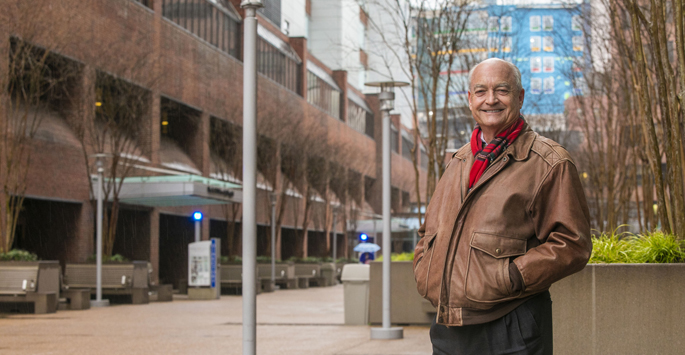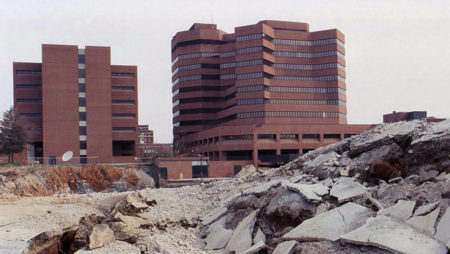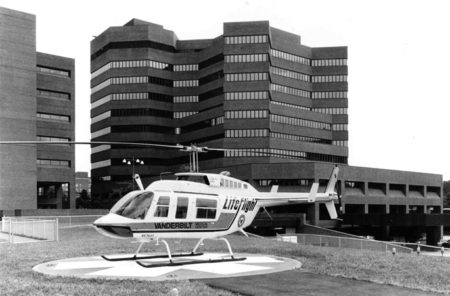
It’s a crisp February morning and Ken Browning, just a few days short of his retirement, let his gaze travel down the Medical Center plaza. From where he stood, just outside Medical Center North, a three-block long canyon of buildings stretches south and forms the heart of Vanderbilt University Medical Center.
It is a very different view from the one he had on his first day at VUMC in 1984.
“Medical Center North was here, of course, and Light Hall, the hospital, Langford Auditorium,” he said, of those earlier days. “And the Medical Arts Building had been here forever (which is another way of saying since 1955).”
Browning directed Space and Facilities Planning for several years before turning that over to Bobby Otten last year. Earlier, in 2015, he stepped down from his role as the leader of Facilities Management, handing over those reins to Gary Streaty.
His transition to retirement has been well-planned and well-executed, which means that it looks exactly like a typical Ken Browning project.
For most of the 35 years that he has worked at VUMC, through a variety of changing job titles, department names and reporting relationships, Browning has been at the forefront of planning, constructing and maintaining the buildings of the Medical Center campus. When he began, the campus had a little over 2 million square feet. Today, including the parking garages, that figure is more than 10 million.
And if you walk around for a while talking to him, it’s as though Browning’s memory combines with X-ray vision into the infrastructure and history of the Medical Center’s buildings.
Mention the recent opening of the relocated Clinical Research Center on the second floor of the Round Wing, and his mind isn’t on the gleaming new patient care areas; he wants to talk about the new system for air handling for the whole wing.
“That was kind of a fun project,” he said. “It included replacing some big fans down in the machine room of the Round Wing that were almost 60 years old. It was kind of a nice thing to get that old equipment out of here and have new stuff for the guys to be able to maintain.”
That concern for both the well-being of the building and for the satisfaction of the employees who work every day to maintain it seems to be a distillation of Browning’s philosophy.
Walking south along the hospital plaza, looking upward at some of the buildings he helped plan, construct and oversee, Browning talked about how the nuances of each project shaped its outcome.
“Buildings have personalities,” he said. “A research building is different from a clinical building. The construction of each one of them is a little different as far as logistics that you have to work around.”
The biggest current project at VUMC is the addition of new floors to Monroe Carell Jr. Children’s Hospital at Vanderbilt, and Browning’s command of the details of the project are much better than you’d expect of somebody looking toward retirement.

He talks about how important it was, in adding two additional elevators to the building, to do the work with as little noise disruption as possible — and details one of the ways it was done.
“Normally you pour a slab, and the mechanical and electrical trades come in and they start drilling anchors into the slab to hang their conduit and pipe from,” he said. “With new GPS technology, they laid out their pipe-hangers before the slab was poured. So, we probably cut 95 percent of the overhead drilling.”
All that meant a more precise job, less noise and disruption for patients and a safer project for workers.
Browning pauses for a minute after telling that story, smiling a little to himself, maybe thinking about how the planning, thought and effort were hugely successful and, as a result, completely invisible to almost everybody.
Nobody ever phones to say the power is on, water is flowing nicely, and the temperature is very comfortable. Most infrastructure is, after all, pretty much taken for granted until there’s a problem.
And, of course, Browning knows better than anybody that there will be problems. In a place with as many miles of water lines, electrical wiring, ductwork, pneumatic tubes and other infrastructure elements as VUMC, there are going to be challenges of some sort every day.
“This place — there’s always an opportunity to have a breaker trip and lose power, have a pipe rupture. Or Mother Nature comes along, like in 2010, and floods the basement of TVC and Children’s Hospital,” he said, shaking his head at the memory of those tense days when half of Nashville seemed to be under water.

Browning’s even-keeled personality is probably one of the things that allowed him to function in such a high-pressure role for so long, but another aspect is the obvious pleasure he takes in the buildings and his colleagues who oversee them.
He opened an unmarked door in the basement of The Vanderbilt Clinic. “Here’s something that’s pretty cool,” he said. Inside is a several-hundred-square-foot room with series of winding and interlocking pneumatic tubes that, viewed from a catwalk above looks like a giant plate of spaghetti.
“We’ve got a pneumatic tube system at this facility that we’ve been told is the biggest pneumatic tube system in the world,” he said. “It’s got about 500 stations on it. You can send a pneumatic tube from the 10th floor of Children’s Hospital to the eighth floor of the Round Wing if you want to.”
As he speaks, a carrier zips with a thonk into a holding area while the proper tube for its destination rotates into place (there are 10 zones in the Medical Center), and the carousel of tubes aligns so that the carrier is aimed to its destination. The carrier then jets out with a satisfying whoosh.
“We run about 4,500 transactions through this system every day,” Browning said. “The main users are the pharmacy and the clinical labs,” he said. “It’s a huge piece of the infrastructure.” And the thought comes again, that this is one of the many parts of Browning’s former areas of responsibility that, if it works well, is practically invisible.
As he walks up Medical Center Drive back toward Medical Center North, somebody asks Browning to list the buildings that he has planned or worked on during his 35 years. The names come easily: “Medical Center East (both towers), the Dayani Center, TVC, the Critical Care Tower, MRB 1 (now the Robinson Building), MRB 2 (now the Preston Research Building), MRB 3 (now part of Vanderbilt University), MRB 4, the Vanderbilt Psychiatric Hospital, Vanderbilt-Stallworth Rehabilitation Hospital, the Eskind Library, Children’s Hospital.” And, in addition to that, parking garages, some new and some expanded.
Quite a legacy.
But, after 35 years and millions of square feet of new construction, and hundreds of employees, and projects planned and crises managed, you ask him what he’s proudest of, the answer comes without hesitation — the Medical Center’s free ride-to-work program in partnership with the Metro Transit Authority.
The program allows employees to take city buses to and from work for free. Browning researched the way the program could work, looked at what it would cost the Medical Center to implement the program and what the savings would be in parking construction and maintenance.
“It’s an economic benefit to employees. It helps solve our parking problem. And it costs less money. It was such a win-win-win all the way around,” he said. “Now there are about 500 to 600 people a day using the program. That was one of my proudest achievements.”
This answer may be a little surprising, but it has a lot of Ken Browning’s way of thinking in it. The ride-to-work program helped solve an infrastructure problem — parking. It helped people by saving them money. It made the institution stronger.
Browning added one more thing: “Of course, it took a lot of people to make it happen.”
Because sharing credit is part of his legacy, too.
His last day at VUMC is Feb. 28.












